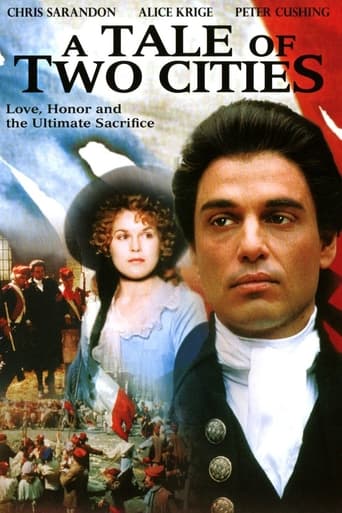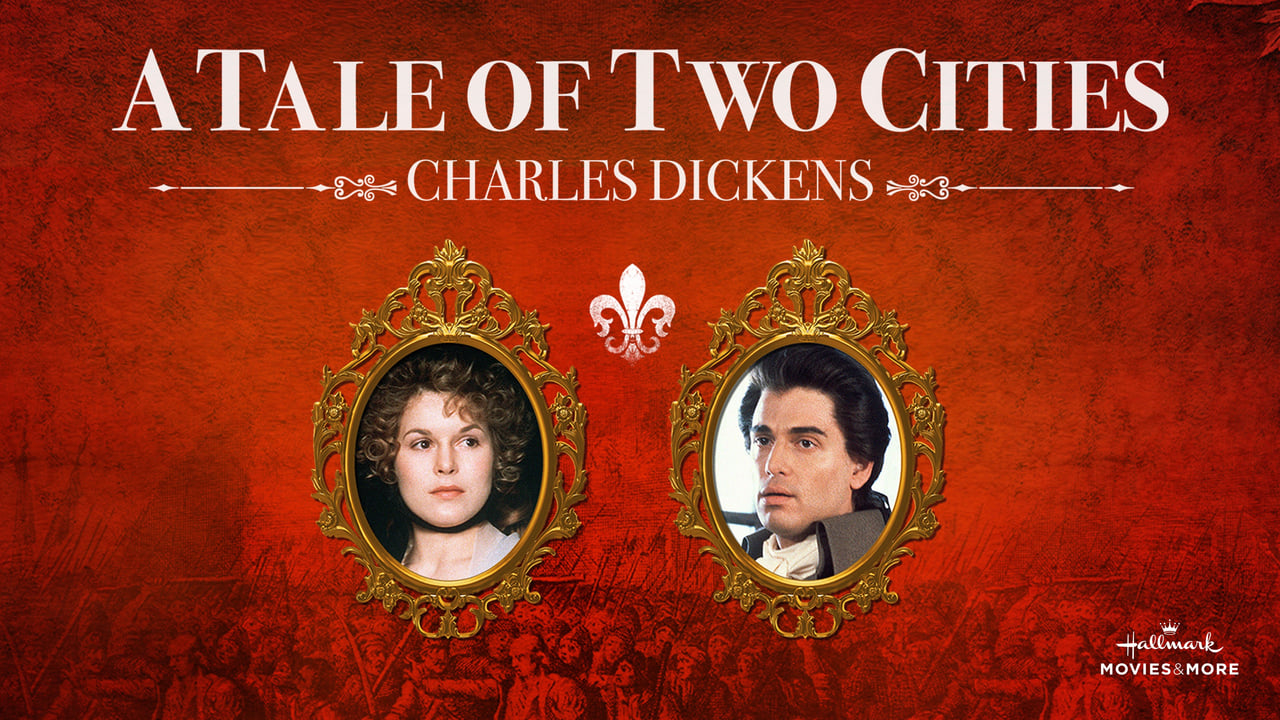TheLittleSongbird
A Tale of Two Cities is a wonderful book, ranking Dickens' works it's to me towards the top. It is wordy with a very complicated story, but it is also very compelling and the characters especially Sydney Carton and Madame Dufarge are memorable. This 1980 version is not the best(the 1935 film) or worst(the animated Burbank Films Australia version) of the book, but adaptation-wise and on its own it's very decent. It is hampered by Chris Sarandon's stiff and emotionally cold Charles Darnay, a rather cheap, under-populated and lacking-in-suspense-and-urgency storming of Bastille scene and the on-the-saccharine-side romantic theme in the music score. The adaptation could also have done a better job at differentiating between Charles and Sydney, visually especially with the hair they are never quite distinctive enough. But the production values are generally quite decent, it does at least make an effort to be true to Dickens and the historical period it's based in and they have good colour and atmosphere if lacking somewhat in refinement. The music serves the adaptation well, while the script is intelligently adapted and does nobly with conveying Sydney's sardonic humour, the heartfelt tragedy at the end and the dark, foreboding humanity. The story is faithful in spirit to the book, though there are things inevitably missed out, and doesn't feel too confused. It's solidly paced too. With individual scenes the standout has to be the ending which is extraordinarily moving, though the final forty minutes generally is very suspenseful. The acting is fine on the whole. While Sarandon disappoints(to me at least) as Charles he is outstanding as Sydney- that Sydney is a far more interesting character helps-, he is humorous and sardonic while also poignant and dignified. Alice Krige is an emotive and beautiful Lucie, Flora Robson's Miss Pross is regal and loyal and Barry Morse is rightfully hissable as Evremonde. Billie Whitelaw is fine as a very snake-like Madame DuFarge, David Suchet characterises the conflicted character of Basard brilliantly and beautifully, Peter Cushing is perfect as Dr Manette and Kenneth More is more than competent too. George Innes does a very good job too as Cruncher, very sly and funny, but the character could have been more prominent. In conclusion, decent version, worth watching but for the best adaptation look to the 1935 film. 7/10 Bethany Cox
howardmorley
Yes,I know this is a TV version and therefore impressionable children may be watching, (even after the British 9pm watershed) but the final guillotine sequence was wholly unconvincing.I went with my late parents in 1965 to the Conciergerie on the Ile de Paris where they imprisoned the condemned, before their final ride in the tumbrils.There they had a room where they severely cut off the hair of the condemned because otherwise the blade would not cut through the neck cleanly.Yet again producers do not do enough technical research regarding being dispatched by "The National Razor".The 1935 version with Ronald Coleman was farcical in this respect.As he came up the stairs he had his high collar up before issuing forth with, "It is a far far better thing...." speech.In the subject 1980 TV version, you have Chris Sarandon as Sydney Carton mounting the scaffold stairs with shoulder length hair! There are many other films which inaccurately portray the methods used in capital punishment and it was not until I saw Timothy Spall in "Pierrepoint" that we saw an accurate rendition.I know this is a bit ghoulish but I would rate the overall production as just about "adequate" and I awarded it a rating of 6/10.It was good to see Kenneth More in one of his last roles as Jarvis Laurie.
jason-210
A reasonably good interpretation of the Dickens classic, which sticks to the book quite well.Some of the acting was excellent, in particular Chris Sarandon who was perfectly cast as Sydney Carton / Charles Darnay. His portrayal of the complex Carton in particular was very clever and convincing. Cushing also was well cast as Manette and played it perfectly, while Kenneth Moore delivered his role competently was one would expect.Unfortunately the film is marred by poor, low budget 1970s television production and art direction values. It is mostly unconvincing in its portrayal of the revolution, especially the action scenes. One of the problems with early television adaptations, especially those by the BBC from the 1960s and 70s, is that they think "dramatising" means simply adding pictures to text. They assumed that if you were faithful to the events and dialog, and dressed people up in period costume, then you've done a good job. The storming of Bastille seems like a routine amateur theatrical depiction, where the extras clearly had a minimum of choreography and direction. There just weren't enough revolutionaries to create a convincing atmosphere of chaos and terror. These problems were further exacerbated by the stereotyping and poorly acted roles of the key revolutionaries Monsieur and Madame Defarge.The ending has one notable and moving scene - the meeting and very brief love encounter between Carton and Seamstess before the guillotine, again made possible by the Sarandon's excellent portrayal of Carton.At the time of writing the film is currently available in a boxed set of three DVDs in the "Best British Classics" series in Sweden. The the series is designed for Swedish audiences but the films are in English with the option of subtitles. A quick search on the Internet on Google.se for "Best British Classics" should give you some hits.
kwongers
First things first: I have to say I have never read Charles Dicken's book, but after seeing this movie, I'll be stopping by the state library to pick it up. This is a GREAT movie - enjoyable, moving, and historically convincing. (My history teacher made us watch it to see what the French Revolution (especially the Reign of Terror) was like.)
After reuniting with her father, Dr. Manette (they had been separated from each other for many years), Lucie Manette goes back to England, where she meets a handsome stranger, Charles Darnay. Darnay is really Charles Evremonde, a French aristocrat who disdains his vain and arrogant uncle and who runs away from France. They fall in love and marry. But there is an English lawyer, Sydney Carton, who also loves Lucie. When Darnay returns to France to save his servant, he is thrown into prison and besieged by all the foolishness and speculation of the French Revolution. I won't divulge any more of the story to you.but I have to say the ending is really, really great. It's so moving that I can't watch it without crying at least a little. (Yeah, I cried when we were watching it at school, and hopefully no one saw me.)For others who know the story, I can't tell you if the movie lives up to the book, but I do think the movie is a very convincing depiction of what happened during the French Revolution. Madame DeFarge, one of the `revolutionaries' (ha!), embodies the spirit of the common people during the Revolution. She felt it was absolutely necessary to kill a lot of nobles, even if they were innocent and had done nothing wrong. In the court scenes, we see how unfair the French tribunals are; defendants are barely given the chance to speak and they are convicted on little evidence and a lot of speculation. (The film compares the French court to the English court, which is infinitely more just.) We see the so-called anti-Revolutionaries being marched to the guillotine.it's a very moving moment. The film works very well because it doesn't lose any part of the story or the historical background. They work very nicely together.To single out someone for acting, I have to commend the talented Chris Sarandon, who played Sydney Carton and Charles Darnay. That must have been really hard to do, especially since Darnay gets everything he wants and Carton doesn't. It's great acting. However, Sarandon manages to stay on course and the results are wonderful. He manages to combine jealousy, love, and strength all in the same gaze.
A WONDERFUL film.it gets your anger going, pulls on your heartstrings, and keeps you perfectly enraptured through the entire running time. I loved this movie. 10/10


 AD
AD



